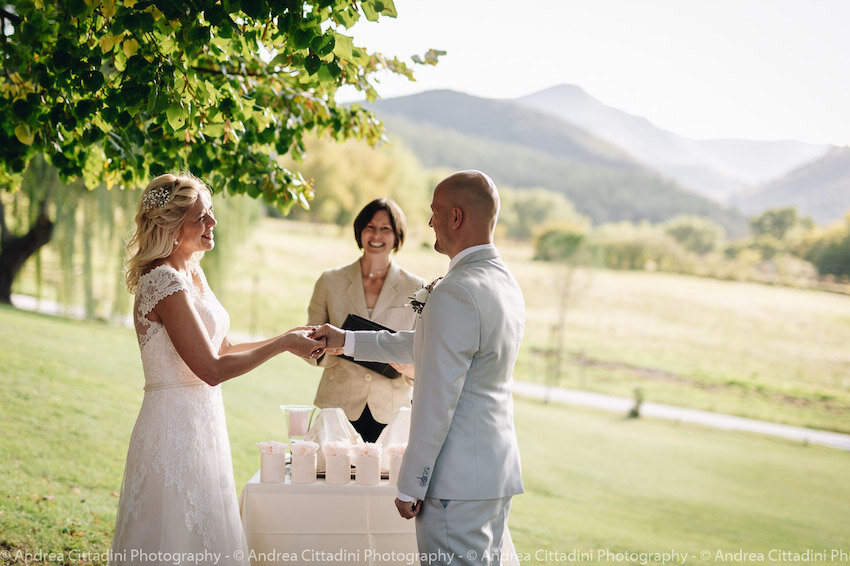Micro weddings is the current buzz word for small, intimate weddings, generally considered those with no more than 20-30 guests. They are also sometimes known as “minimonies”. They should not be confused with elopements, which are weddings with just the couple and the celebrant.
For obvious reasons, they have become a trend in 2020, but in fact many couples were already having them before, especially those who chose to have destination weddings.
Celebrant Sarah Morgan during Emily and Ben’s wedding ceremony an olive grove. Photo by Chris & Ruth
As celebrants working in Italy, we have done many weddings now considered “micro” and from this experience can talk about why some couples choose them over large, traditional weddings.
The wedding ceremony in its essence is about two people standing before their most intimate loved ones and vowing to pledge their lives to one another. A micro wedding ceremony can be very powerful because everyone there is particularly emotionally involved in the moment. It may also mean that the guests were more hands-on in the preparation. For example, at Silvia and Elliot’s wedding when I arrived hours before the ceremony I found their friends and family setting up the chairs and arranging the flowers. It is also easier to involve all the guests in symbolic rituals such as ring warming or forming a circle around the couple if the group is small, such as with Paige and David’s wedding. Some couples, especially shy or reserved ones, find traditional weddings, in which they would be the focus of attention in a large public setting, too much pressure, and so a micro wedding can be the solution.
Video of ring warming during wedding ceremony at intimate wedding in Italy with celebrant Clarissa Botsford looking on
For many couples, having fewer guests to worry about means that they can be more relaxed during the preparation phase and above all on the big day. It means they can spend more time with each guest.
Cost may also be a reason for the couple not to have a large wedding, but some couples, instead of saving money, chose to spend more days with their guests. For example, Ben and Emily from New Zealand had their wedding ceremony at the end of a week spent with their dearest friends and family members so it came as a culmination of an amazing sojourn, of a shared experience.
From the celebrant’s point of view, I have to admit I love to do weddings without a microphone. It is also easier to be flexible in terms of when to start the ceremony in case of shifting weather if there are fewer guests to shepherd around.
That said, micro weddings are not for everyone. Many couples dream about having large weddings and they have their own advantages. Disappointing family members and friends by not inviting them to your small wedding is undoubtedly the biggest drawback. However, they can be combined with a party or a series of celebrations in order to share the experience with everyone (perhaps even projecting images of the wedding ceremony).

















